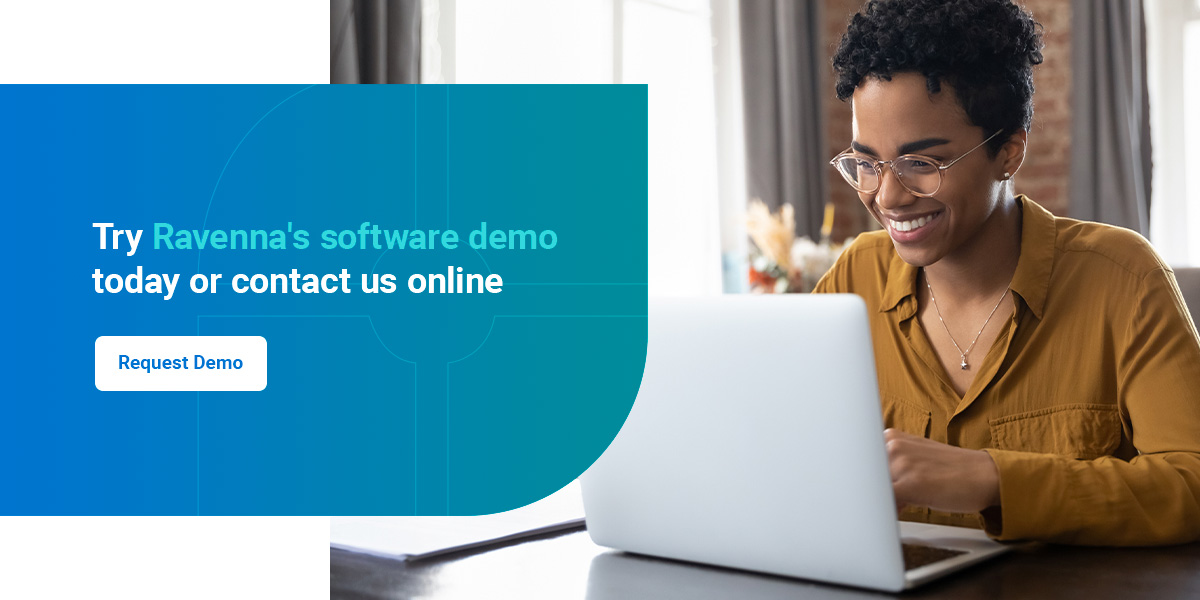Digital Transformation in K-12 Education

Digital transformation in K-12 education ensures schools shift their mindsets towards improvements and updates in technology. When it comes to the impact and challenges of digital transformation in education, learning how updated technology works can help your school find solutions to common problems while preparing for the future.
More industries are revolutionizing the way they do business through technology. Schools that use digital transformation are better equipped to set their students up for success, making these schools more appealing to families.
This guide will help you understand digital transformation trends in K-12 schools and how updating your processes can be a digital solution for education. We’ll also guide you through how you can implement digital transformation within your school and how it can benefit specific processes.
Table of Contents
- Chapter 1: Digital Transformation: What It Means and How It Works
- Chapter 2: How Digital Transformation Can Help Your School
- Chapter 3: Streamlining the Admissions Process
- Chapter 4: Efficient Financial Aid Processes
- Chapter 5: Automating the Enrollment and Tuition Process
- Conclusion: Bring Your School Into the Future
Chapter 1: Digital Transformation: What It Means and How It Works
Many industries are shifting their focus toward digital transformation to improve their processes and meet customer expectations. The digital transformation process revolutionizes how different industries do business, setting them up for success in the modern world. The education industry can also benefit from digital transformation as it replaces outdated processes and sets students up for success as they strive toward their future. This section explains digital transformation and how it can benefit the education industry. We’ll also help you determine whether or not digital transformation is the right choice for your school.
What Is Digital Transformation?
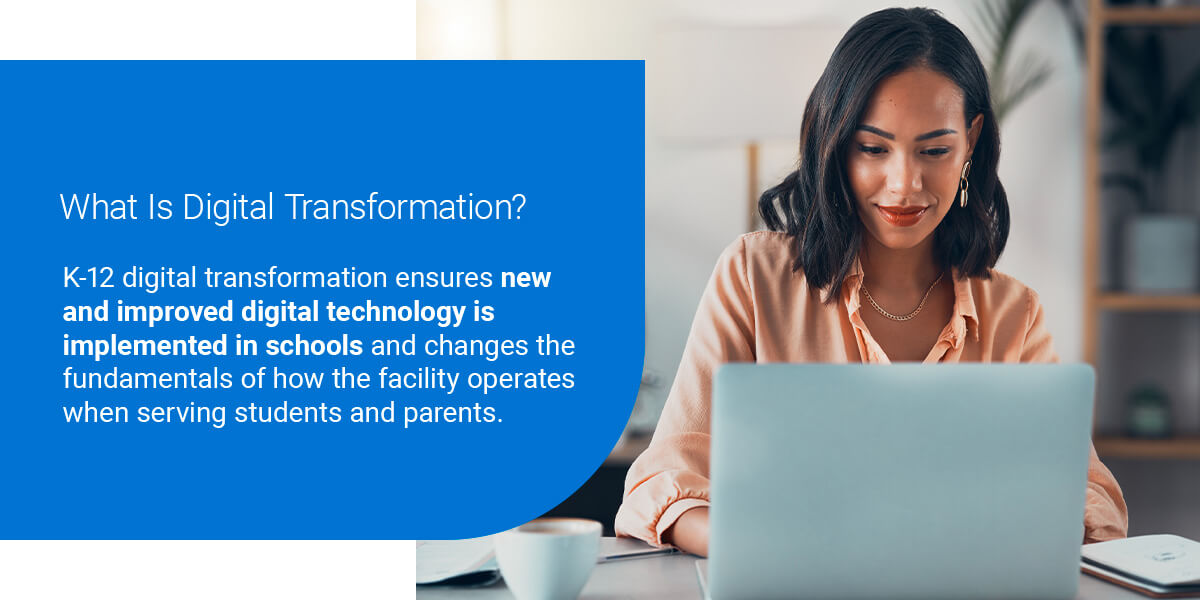
K-12 digital transformation ensures new and improved digital technology is implemented in schools and changes the fundamentals of how the facility operates when serving students and parents. Digital transformation aims to make processes effective and efficient compared to older technologies. Through new technology, your school can challenge the status quo, experiment with new opportunities, and try new practices.
This requires a cultural shift within the organization. If you update old practices with new technology, you’re simply digitizing, not transforming. You can only digitally transform your school by shifting your thinking about current processes, but it can take time to transform the mindset and culture within your school, especially if families, students, and staff are accustomed to outdated practices. You can encourage the cultural shift by fostering innovative ideas and reporting measurable improvements after implementing changes.
Digital transformation begins with three essential parts—a problem statement, an opportunity, and a strong goal. Each area helps your school understand why your facility wants to transform its current technology. While digital transformation can be effective in many businesses and industries, the education industry can benefit significantly by making the change. Digital transformation can target any individual within the educational industry, including teachers and students, administration, or staff. You can streamline various processes and create new opportunities for learning through digital transformation.
Current Trends in Digital Transformation
Exploring current trends in educational digital transformation can help convince your stakeholders of its benefits. Some digital transformation trends include the following:
- School management suites: Comprehensive solutions that include software for all school management functions for a streamlined experience.
- Registration: Admissions registration using a website or mobile application on students’ phones.
- Online platforms: Online student organization through streamlined platforms for coursework and projects.
- Interventions and progression: Tracking student progress through data and designing intervention programs to help find and reach out to struggling students.
- Online learning: Options for students to attend class online or access projects remotely.
- Online admissions: Online admission assessment options for students and parents.
- Learning platforms: The implementation of interactive learning materials and platforms.
- Tracking and data: Using data to track students’ performance and assess their progress during the year.
- AI implementation: Using AI assessments and analysis and AI proctoring for tests.
- Finances: Options for online payments, transactions, and financial aid.
- AR and VR: Augmented reality (AR) or virtual reality (VR) ensure increased engagement in the classroom and help make lessons fun, allowing kids to interact with history using VR or make science safer with simulated experiments.
- Smart classrooms: Many schools have implemented smart classrooms and updated their in-class technology to use smart software for lesson planning and smartboards for easy teaching.
- Personalized learning: New technology tracks student learning styles and preferences to create lessons and classwork based on their personal needs.
- Accessible learning: Schools can reach students in different locations, offer better assistance to students with specific learning needs and ensure students with disabilities have the technology needed to make learning easy.
- Data privacy: Using two-factor authentication, encryption, backups, and other data privacy software to ensure essential information is secure.
- Blockchain security: Secure record-keeping through blockchain security measures.
Technology has many applications in the educational industry, whether you’re streamlining the admissions process, tracking student progression, or looking for new methods to further learning. Using technology will also set you apart from other schools that haven’t transformed, increasing your enrollment rates and student retention.
Is Digital Transformation Right for Your School?
If you’re wondering whether or not digital transformation is suitable for your school, think about how your current processes run and the problem areas you notice. For example, some schools struggle with enrollment or admissions due to outdated practices. Technology can help schools find new approaches to applications, view decision letters quickly, and collect family and student data in one centralized platform.
Here are a few areas to consider when asking yourself whether digital transformation is right for your school.
1. How Accessible Is Your School?
Think about how accessible your school is to students with specific learning needs, those learning from home, or students who need technology to learn better. If you think you could do more for these students, consider digital transformation software, which can help you reach students worldwide and provide accessible learning tools to students with disabilities. Items like text-to-speech tablets or online applications for remote learning can improve accessibility.
2. Where Does Your School Emphasize Personalized Learning?
Does your school emphasize the personal learning needs of its students? Or does it use the same learning styles for every student, regardless of their specific requirements? Every student learns differently, and digital transformation can help track student progress, learning styles, and classroom needs. Teachers can provide each student with a personalized learning experience through new technology and processes to improve their academic success.
3. How Has Engagement Been?
Ask yourself how much students are engaged with the school’s learning material. Digital transformation can help improve engagement with students in the classroom. Students may be more excited to learn and find classwork interesting through tools like smart whiteboards, tablets, computers, chatbots, VR, and AI. Digital transformation also helps students engage with each other through tools like online chat rooms or shared learning software with accessible lesson plans.
Additionally, consider family engagement—how does your school communicate with families? Are families seeking more modern communication options? The latest technology can send automatic communications via phone call, email, and portal messaging to ensure families stay up-to-date and encourage engagement with your school.
4. How Safe Is Personal Information?
How does your school store private information about parents and families? It may be time for digital transformation if you still stick to traditional processes for storing personal information and student data. Protecting students’ and teachers’ physical safety is also a priority. Some safety tools for improved physical safety also include CCTV systems, IP cameras, artificial intelligence, and Internet of Things (IoT)-enabled sensors.
5. Do You Need More Information and Data on Student Progress?
Is it hard for your school to track student progress or keep data on students updated? Perhaps you’d appreciate it if it was easier to implement strategies for student intervention and tracking struggling children. For schools that require more student data and information, digital transformation can help. By transforming your data processes, you can pinpoint which students need extra academic assistance and track data on progress to ensure each student is prepared for graduation.
Download the Guide
Download the full guide in PDF format.
Chapter 2: How Digital Transformation Can Help Your School
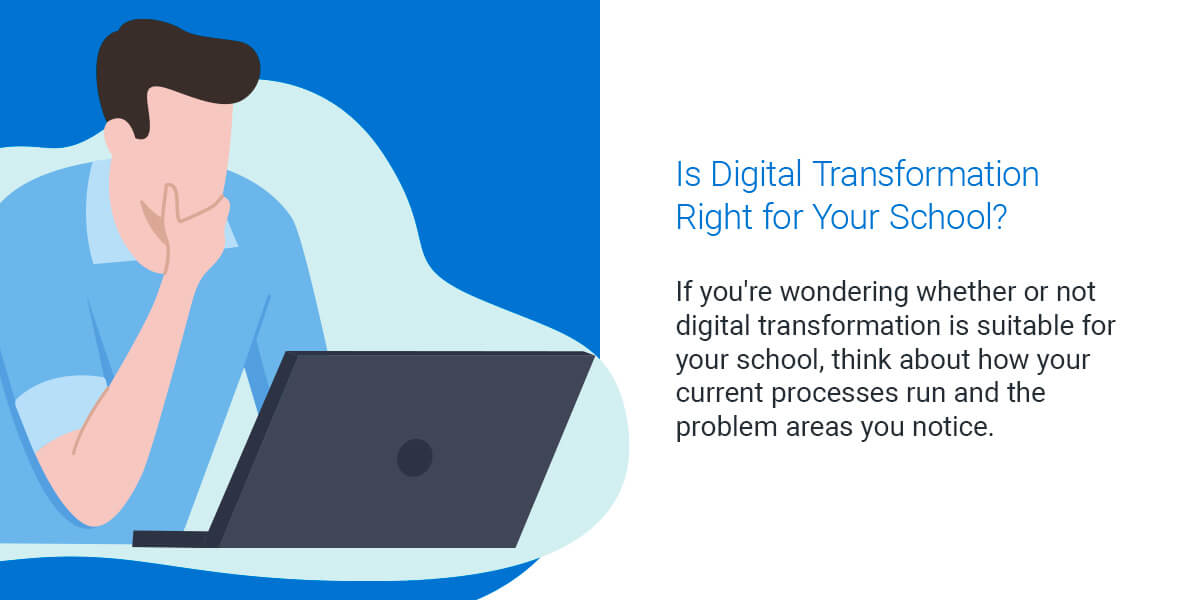
Digital transformation can help your school perform efficiently and stay up-to-date with the latest technology to facilitate learning. An action plan is essential to effectively implementing new technology in your school. We’ll explore how to develop your digital transformation strategy and how digital transformation can benefit your school.
Creating a Digital Transformation Strategy
Digital transformation is about more than building a new website or creating a new app. It’s a complete overhaul of old processes for something new and innovative. If you commit to digital transformation for your school, you need a strategy to make the transition smooth and efficient. A digital transformation strategy requires thorough and systematic care to implement new technology.
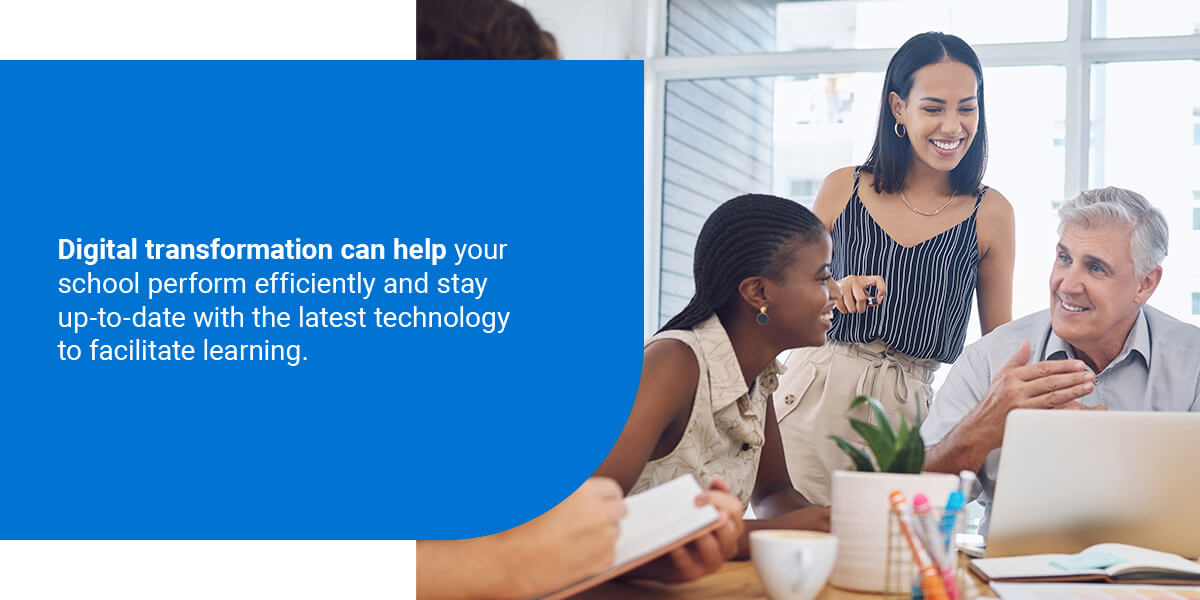
The Key Elements of an Effective Strategy
Include key elements during digital transformation to ensure full implementation rather than simply digitizing outdated processes. Each staff member, teacher, or school counselor needs to have an open digital mindset so you can truly make the changes you need to achieve your goals. Consider the following elements when creating your own digital transformation strategy.
1. Identify Your Problems and Goals
Before implementing new technology and processes, you must identify why you’re committing to digital transformation. Moving forward without identifying the “why” questions and answers gives you a solid direction. Identifying issues and creating goals allow you to measure the results of your digital transformation strategy so you can make changes when necessary.
First, look for any problem areas within your school. If you’re struggling with admissions, you’ll want to implement technology that can help streamline these processes and maximize your efficiency.
Next, you’ll want to identify the goals you want to achieve. For example, you may want to improve communications between administrative staff to assist with project and meeting planning or implementing new educational initiatives. If you identify this goal, you can work on executing it by using automated technology that allows you to deliver messages and collaborate with other administrative staff members.
2. Prepare to Foster Cultural Changes and Handle Resistance
Digital transformation is more than just digitizing old processes. It requires an entire mindset shift, and some people are bound to resist these changes at first. After all, people are at the heart of digital transformation, not technology. It will take time to transform the mindset and culture of every individual, especially if they’re accustomed to older practices and processes.
Ensure you’re fostering these cultural changes with the tools to handle resistance. Communicate your values with all team members, including teachers and administrative staff. Encourage them to ask questions and provide them with resources to learn how to use new digital tools. The more you foster these cultural changes, the less resistance you’ll meet over time, and individuals will start to understand your vision for the school’s future.
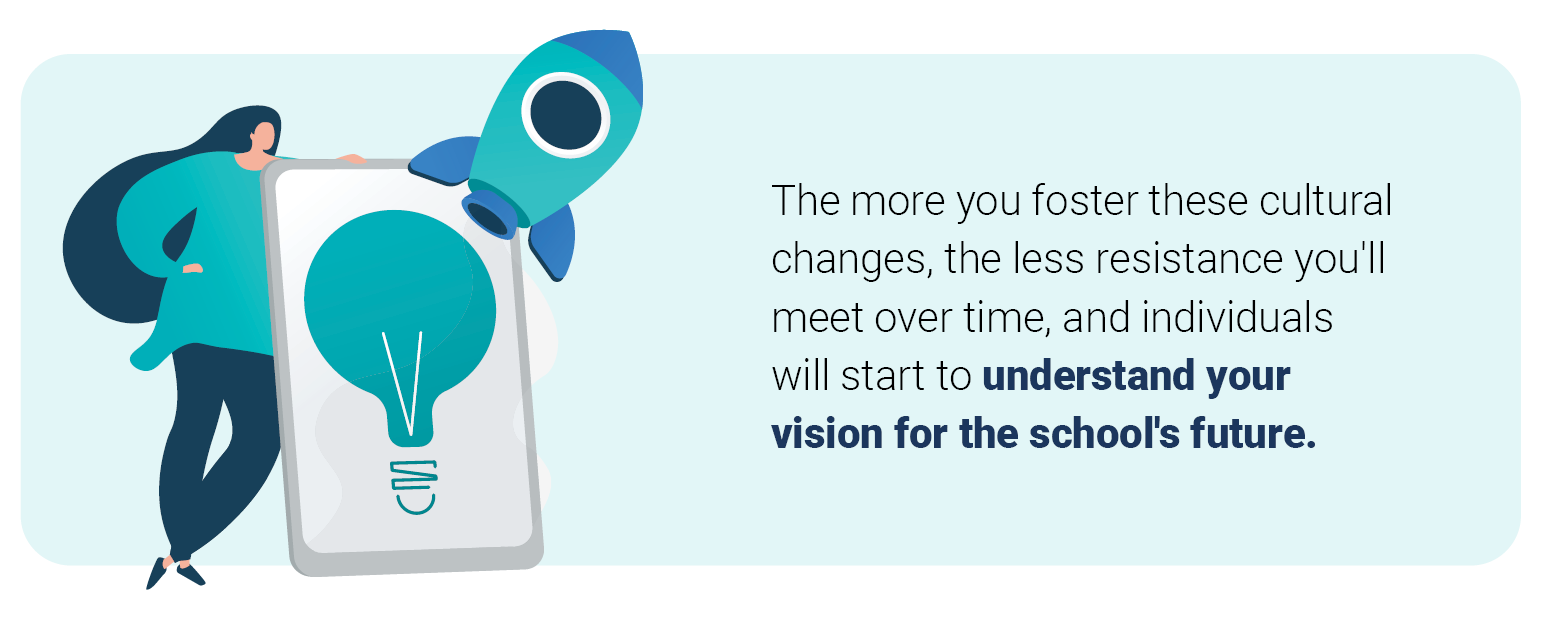
3. Start With Small Changes
Since the cultural shift will take time, starting with small changes can help make the transition easier and set you up for future success. Ensure that the changes you make are meaningful to the goals you’re trying to achieve or the problems you’re attempting to solve. Choose a single project and measure the results after a short period.
For example, you may want more data regarding student progress through the current curriculum to identify where you can improve. Start by implementing technology teachers can easily use to input students’ scores and monitor their progress through their course. These small changes can set you up to make more significant advancements in the future and give your digital transformation momentum.
4. Create a Technology Roadmap
Once you’ve established a foundation and solid strategy, you can implement new technology to achieve your goals and foster change within your school. With a vision in place, you can use technology to leverage your strategy and successfully achieve your school’s goals. Start by outlining what technology you plan to implement first and what you want to use in the future once you’ve achieved some measurable goals. The roadmap will help you keep track of your goals and what will be your next step.
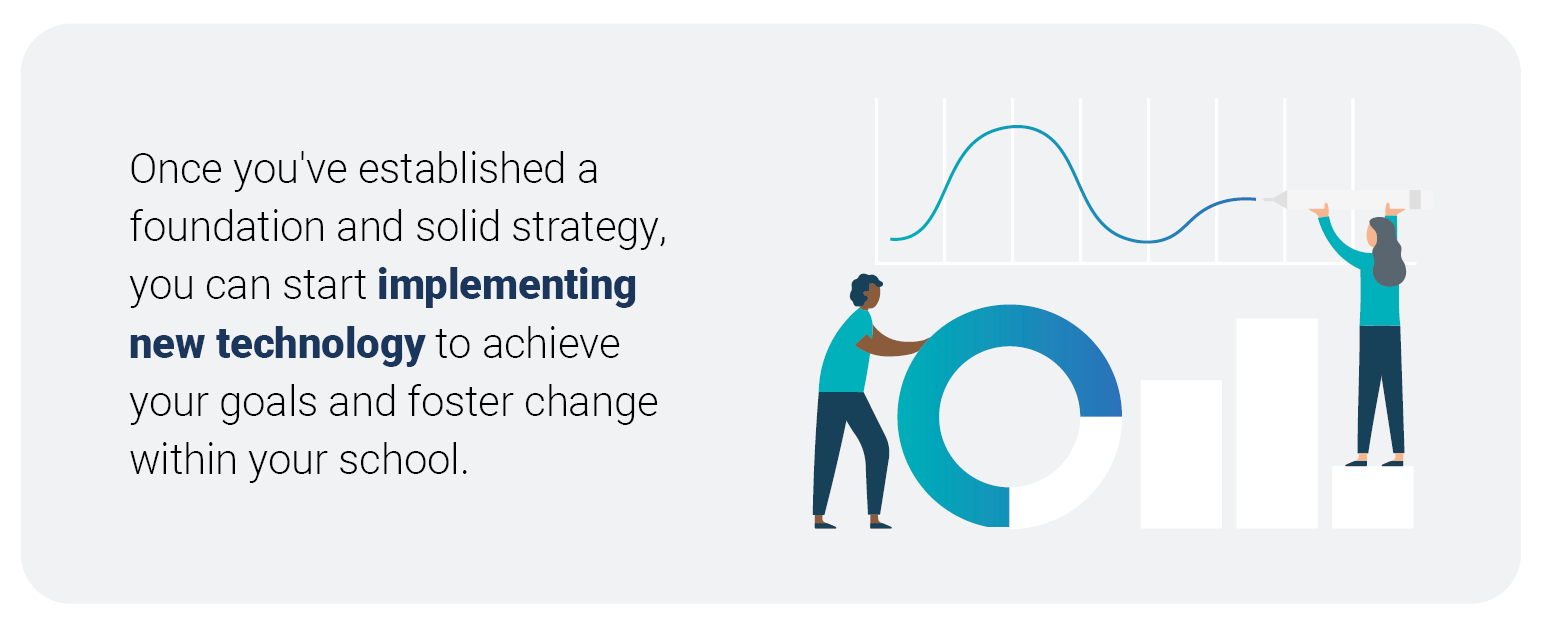
5. Choose the Right Technology and Partners
Not all technology is made equal. Some technology won’t scale as your organization grows, and the partner you select may not be able to support you in the future. When you’re looking for technology for your digital transformation strategy, choose technology that you can use to achieve your short- and long-term goals.
You’ll also want to pick a partner with the right expertise and knowledge in your application to prevent any problems that could set you back. Your chosen partner should complement your strengths and help you be more efficient as an educational institution, driving results and committing to your goals.
6. Collect Data, Analyze, and Take Action
With the other elements in place, you can define what measurable goals and results you’re looking for from each new initiative. Let all your team members know your quantifiable goals so they can help you collect data. Analyze your collected data to determine whether you’re reaching your goals. If you’re not reaching your goals, the data should tell you where you’re falling behind.
You can also collect feedback from teachers and staff to determine if the implemented programs are working as they should. Once you’ve analyzed your data, adjusting is essential to having a successful digital transformation. Having a roadmap beforehand will help you continue down this new path.
7. Keep up Your Momentum
Once you start seeing results for your short-term goals and minor changes, it’s time to continue with the momentum you’ve gained. You can begin to scale your transformation and accommodate larger, long-term goals. Your results will also help shift the culture within your school in favor of digital transformation since it will simplify many processes for various types of staff. More ways to digitally transform your school will emerge as time passes, allowing you to continue finding new opportunities to become a successful educational institution.
The Benefits of Digital Transformation in Education
If you’ve never used innovative technology in your school, you may be unaware of the benefits of digital transformation. Your educational institution can benefit from digital transformation in the following ways.
Allows You to Go Paperless
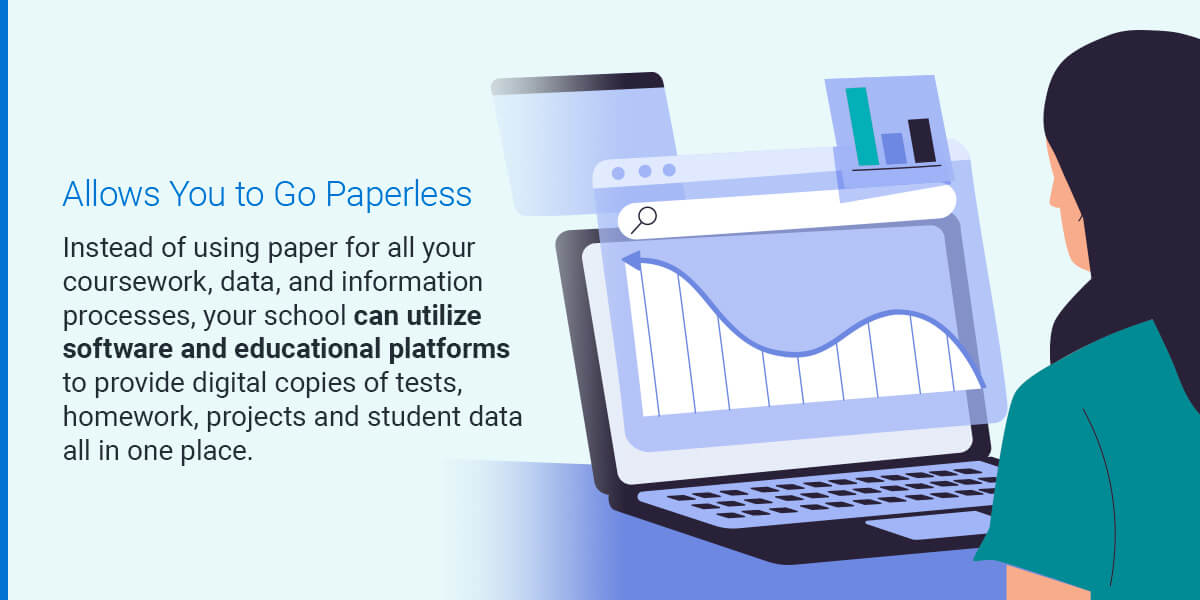
Using digital technology allows you to leave paper behind, reducing the need to sort through files or store them in filing cabinets. You’ll also reduce your carbon footprint by going paperless, making your campus more eco-friendly.
Instead of using paper for all your coursework, data, and information processes, your school can utilize software and educational platforms to provide digital copies of tests, homework, projects, and student data all in one place. For example, digital software like Zoom, Google Meet, or Webex offers reliable ways for students to share information and attend classes online. Other platforms like BigSIS make it easy for teachers to upload copies of homework, projects, and information to minimize the number of physical papers used in each class.
Improves Data Analytics
Technology allows teachers and staff to easily track student information, making it effortless to determine how individual students are progressing through the curriculum. Integrate your various systems to spot problems and find practical solutions. You can also use data analytics to enhance your performance.
Data analytics may assist with specific areas like tracking student progress and creating intervention plans. For example, students struggling in math class may receive faster assistance from tutors and counselors once teachers have the knowledge and data to spot an issue. The more the administration understands about a student, the better they can help them succeed and grow academically.
Saves Time
Digital transformation saves you time with your processes, allowing you to focus on achieving your goals and implementing other strategies for success. You can also maximize teachers’ time by using online learning options for students and help families save time by making applying and enrolling in your school easier.
An example of time-saving strategies through digital transformation is quick admissions and enrollment processes. When families can easily fill out an application online, it saves them time that would otherwise be spent scheduling in-person meetings with administration and asking for forms from faculty members. Another common example is the use of online platforms for handling homework and projects. When students can easily access homework online, it saves teachers from rooting through piles of paper and streamlining the grading process.
Streamlines Processes for Families
Families appreciate it when processes are simplified, such as enrollment, tuition payments, and communication with and within the school. Students and their families can access technology that streamlines operations through digital transformation. They can get tuition payment reminders, enroll multiple students at once, and communicate with your staff to ask questions.
Quick financial tasks are greatly appreciated by families who believe it is easier and faster to transfer money online than by bringing checks in person. With all their questions answered through a reliable web page or automated chat system, your school can also reduce the number of lengthy phone calls by confused parents.
Automated Tasks
Digital transformation allows you to automate tedious and time-consuming tasks, letting your staff focus on other projects and tasks that require their full attention and contribute to your goals.
Automated systems can take control of scheduling, manual paperwork, data input, and other time-consuming tasks. Many employees may spend hours inputting information into Excel sheets when helpful software already exists to do the work for them.
Improves Efficiency
Technology lets you complete manual tasks in simple steps rather than a long, drawn-out process. Your administration can complete tasks automatically and access student files and other important information in one place.
A centralized platform is essential to streamline your processes. When teachers and administrators can access information in one place, it makes it easier to locate information that can help students succeed and grow.
Caters to Learning Style
Another benefit of digital transformation is that it allows your facility to cater to the learning style of your students. With more resources and technology, teachers can keep up with the different learning styles of students and ensure every child receives the right education. Whether your students are shy, outgoing, curious, or hesitant to learn, you can integrate new technologies and processes to ensure every student feels heard and receives the educational care they need.
Brings in Experts
While teachers often have the tools and knowledge necessary to lead their students to success, there is nothing wrong with bringing in other experts to the classroom using digital transformation and new processes. For example, tools like live-streaming platforms and interactive videos create a dynamic classroom with diverse learning methods. Also, the more your students are exposed to new ideas and expert opinions, the more they’ll learn about the world and embrace diversity and inclusivity.
Enhances Teaching Methods
If your school struggles to enhance its teaching methods and educational assistance platforms, consider using digital transformation to improve classroom techniques and teaching processes. Make the classroom more collaborative and interactive with tools like digital learning boards, online platforms with centralized folders for homework and instructional videos, AI tools, or VR options.
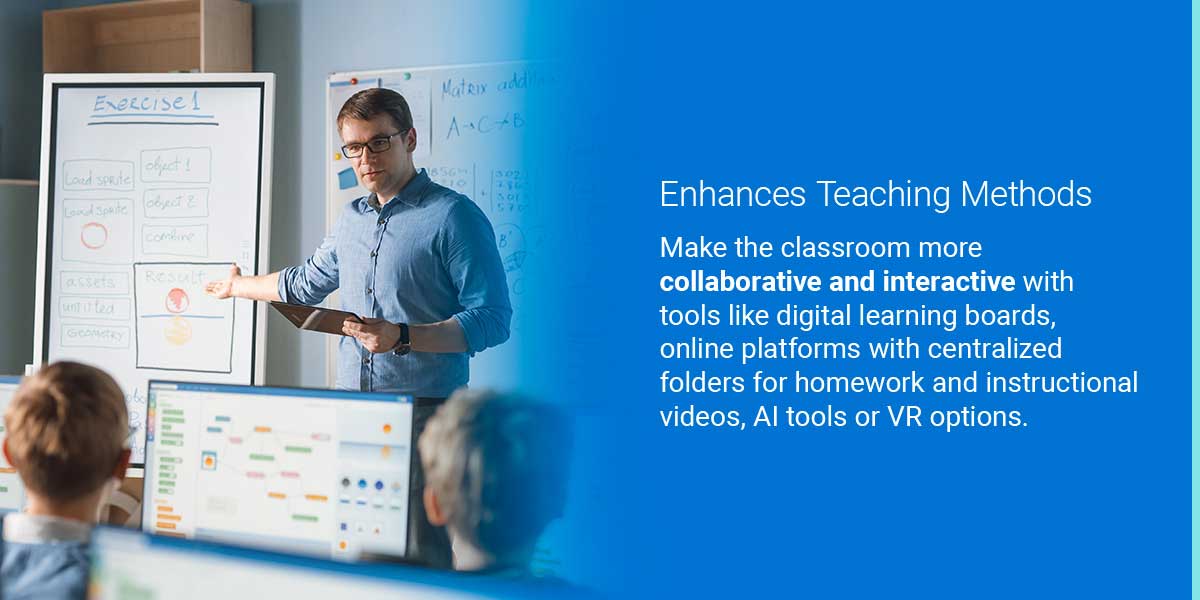
Chapter 3: Streamlining the Admissions Process
The admissions process is the first step for families and students interested in your institution. You want to streamline the admissions process to improve the experience of families and prospective students, making it easier for them to access information and submit their applications. Learn more about private school admissions solutions and how using technology can improve your admissions process.
The Disadvantages of a Traditional Admissions Process
Families’ and students’ expectations of school environments from parents and students continue to evolve as facilities enter the digital world. Innovative digital practices and technology are helping modern education institutions quickly leave behind those that continue to use outdated processes and techniques. Learning the disadvantages of traditional admissions processes can encourage facilities and schools to update their technology and use software, online platforms, and innovative transformation strategies.
Some disadvantages of traditional admissions processes include:
- Relying on students and families: The traditional admissions process relied on families and students reaching out to an institution and creating a relationship with the admissions team. These teams would provide families and students with the information they need to enroll in the school. However, technology has shifted the admissions process, and prospective students and busy parents can easily find the information they need online.
- A high number of contacts: Through digitization, families can often start the admissions process without ever contacting the admission department. However, with a traditional process, your facility may revive a higher number of calls from parents with numerous questions.
- Paper systems: If your school still uses traditional admissions processes and a paper system, families and prospective students could become frustrated and instead choose a school with a streamlined application process.
- Potential student loss: When a facility is not up to date, it could lose students by failing to meet expectations. Families might be more likely to send their children to schools they know are updated and have opportunities to use the latest digital processes.
- Implicit bias: Traditional admissions also leave room for implicit bias, which can affect decision-making. Implicit bias is when a person makes a judgment about a person based on unconscious stereotypes, which disproportionately affect minorities of varying races, sexualities, and genders. Digitizing the admissions process can help prevent implicit bias from influencing the admissions process and allows for more objective decision-making, giving families peace of mind and establishing trust between your institution and prospective families.
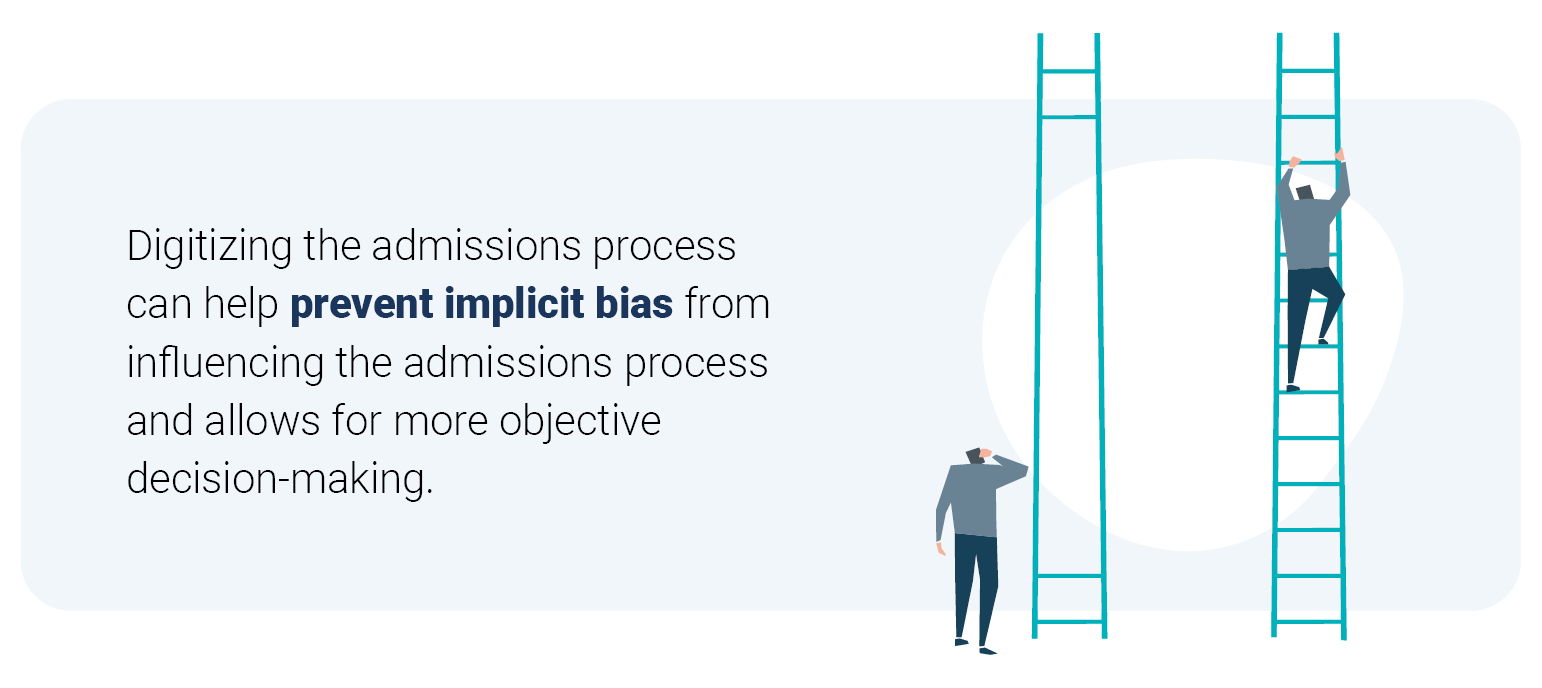
Using Technology to Improve Admissions
Using private school admissions software can help you improve the admissions process and prevent the problems of traditional admissions processes. The benefits of Ravenna software in the admissions process include the following:
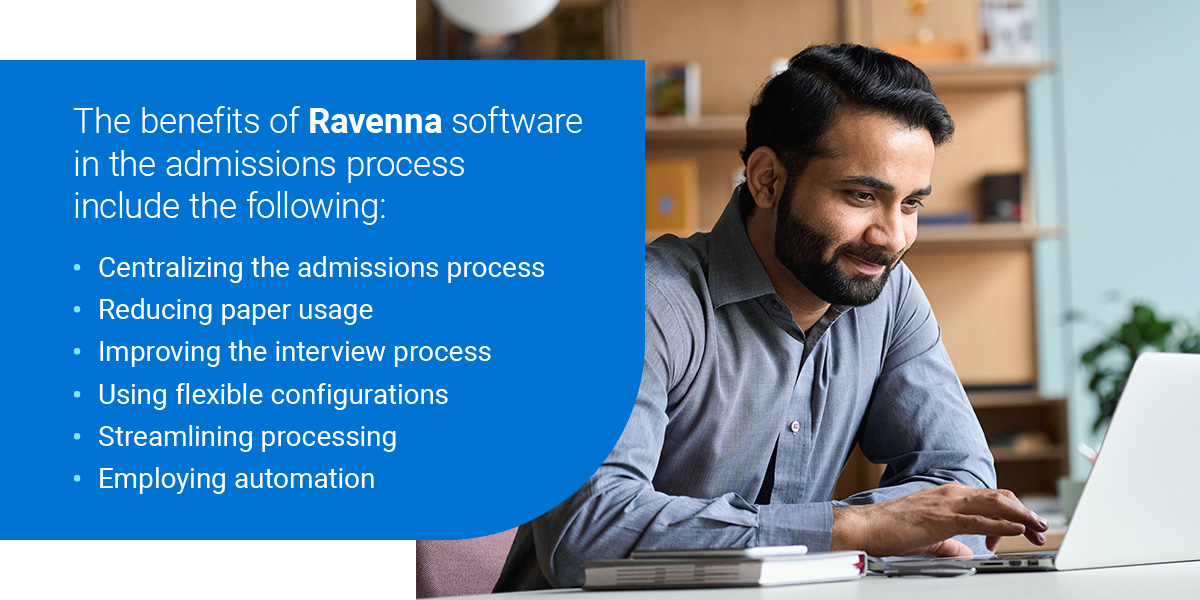
- Centralizing the admissions process: Parents can easily apply from one account and apply for multiple students. Families can also submit forms, plan for events, and view admission decisions in one convenient location.
- Reducing paper usage: Traditional admission processes require an extensive paper trail of information, which often trades hands and can get misplaced or lost. Using technology allows you to keep important information in one place, reducing the risk of human error and allowing you to access files quickly.
- Improving the interview process: Ravenna’s software allows your interviewers to take control of their scheduling, saving you time when determining their availability. The software can even automate scheduling processes while maintaining accuracy and transparency, improving the admissions experience for potential students.
- Using flexible configurations: You can configure the software to your unique needs. With Ravenna, you can use your forms, questions, events, and processes to create a personalized experience for potential students.
- Streamlining processing: Rather than spending too much time processing applications, the Ravenna software allows you to process admissions documents quickly, saving you valuable time.
- Employing automation: Ravenna’s software uses automation tools to handle your hard work, including application segmentation, flagging files and delivering admissions campaigns. You’ll save more time using automation technology and improve the admissions process for administrative staff and students.
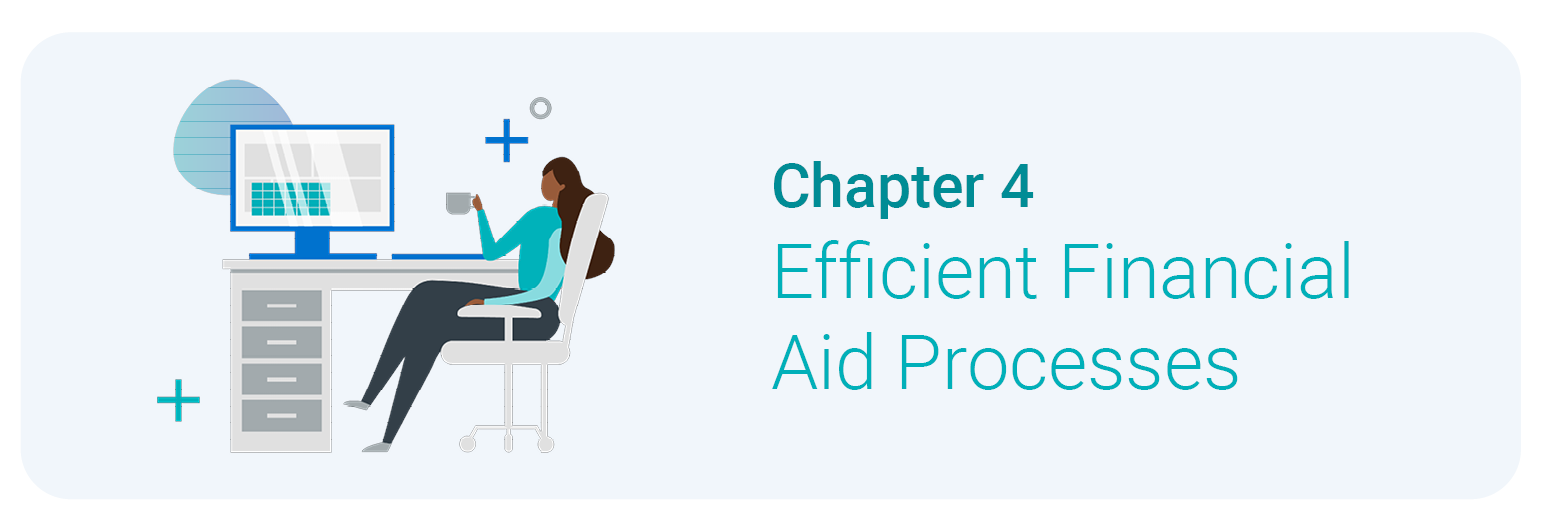
Chapter 4: Efficient Financial Aid Processes
Financial aid is a significant part of the education sector, as many families rely on aid to attend their desired school. While many schools offer aid, they may be using outdated processes that make it more challenging for families to access the assistance they need. Learn how digital transformation can make your financial aid process more efficient for your institution and prospective students.
Managing the Increasing Demand for Financial Aid
Tuition is often a significant barrier for families, preventing them from enrolling in their chosen schools. However, financial aid for private schools is available to help families cover the costs, allowing them to attend their ideal institution. As more people become aware of financial aid opportunities, the demand for financial assistance has increased.
Some private schools report that as many as 46% of students receive financial aid to assist with tuition costs. Families can fill out forms from their desired institution to apply for assistance, but using a traditional system can make it challenging to keep up with demand. Not using technology means parents or students may have to endure a long, tedious process to apply for aid at your institution.
The process is decentralized, creating a complicated procedure for families and administration. Paperwork can get lost, misplaced, or wholly missed during the process, requiring more time and effort from all involved individuals. Financial aid management software provides a solution for administration and families, reducing the risk of human error and drawn-out processes.
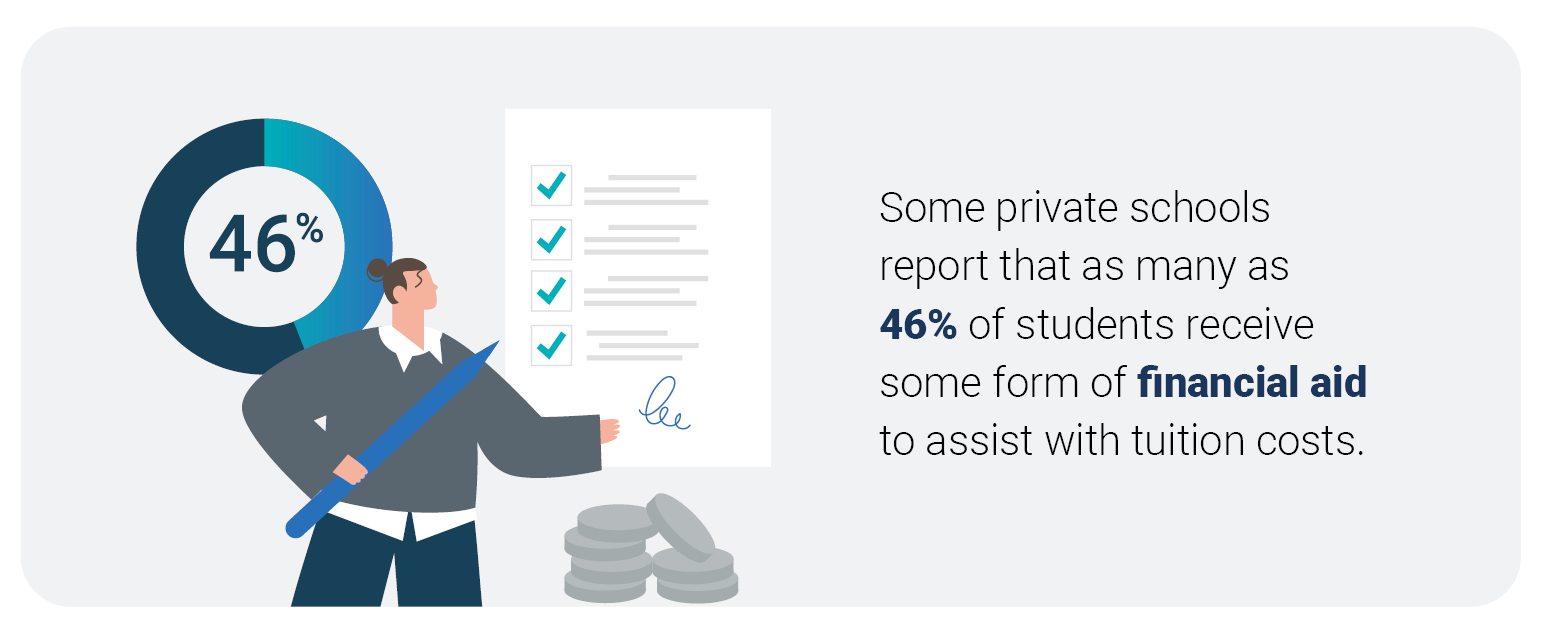
Centralizing and Simplifying Financial Aid
School & Student Services (SSS) is a financial aid software that integrates with Ravenna, providing two solutions for financial aid processes. Both of these technologies help centralize and simplify the financial assistance process. SSS processes applicants’ information unbiasedly, giving families peace of mind that their applications will be processed objectively. All the data that SSS collects integrates into Ravenna’s admission profiles, allowing you to access everything you need in one convenient location. Using SSS alongside Ravenna’s software has many benefits for the financial aid process, including:
- Quick document verification: Once families upload their tax forms into the system, they can receive document verification in an average of 15 hours.
- Fast application delivery: After families have submitted their applications, the system will create a detailed folder you can access within an hour, allowing you to process applications sooner.
- Streamlined application monitoring: The integrated system enables you to monitor an individual’s progress through your application process. You can use this information to reach out to these individuals who didn’t complete the application to encourage them to finish their financial aid applications so they can be processed.
- Easy access to documents and files: The system allows you to view them as soon as families upload them. Access to these documents as quickly as possible makes it easier to streamline the financial aid process.
- Flexible configuration: The integrated system allows you to customize the configuration. You can create a portal to remind families to complete their financial aid applications and keep them on task.
- Applicant award tracking: You can centralize your award tracking using the SSS system, keeping track of applicant data and proposed or approved rewards in one location.
- Centralized experience: Families will appreciate the enhanced understanding of having a centralized system. They can use just one form, regardless of the number of children in the household, and they’ll have access to professional help and assistance throughout the process. A centralized experience will also make it easier for you to process financial aid applications.
Chapter 5: Automating the Enrollment and Tuition Process
Enrollment and tuition are essential to your school’s success, as they help maintain student retention and keep your institution well-funded. When working on your digital transformation strategy and setting goals, consider how you can use technology to revolutionize your current processes and make enrollment and tuition seamless for administrative staff and families. This chapter details the benefits of using enrollment and tuition management software and how they can solve outdated processes.
Easier Enrollment for Everyone
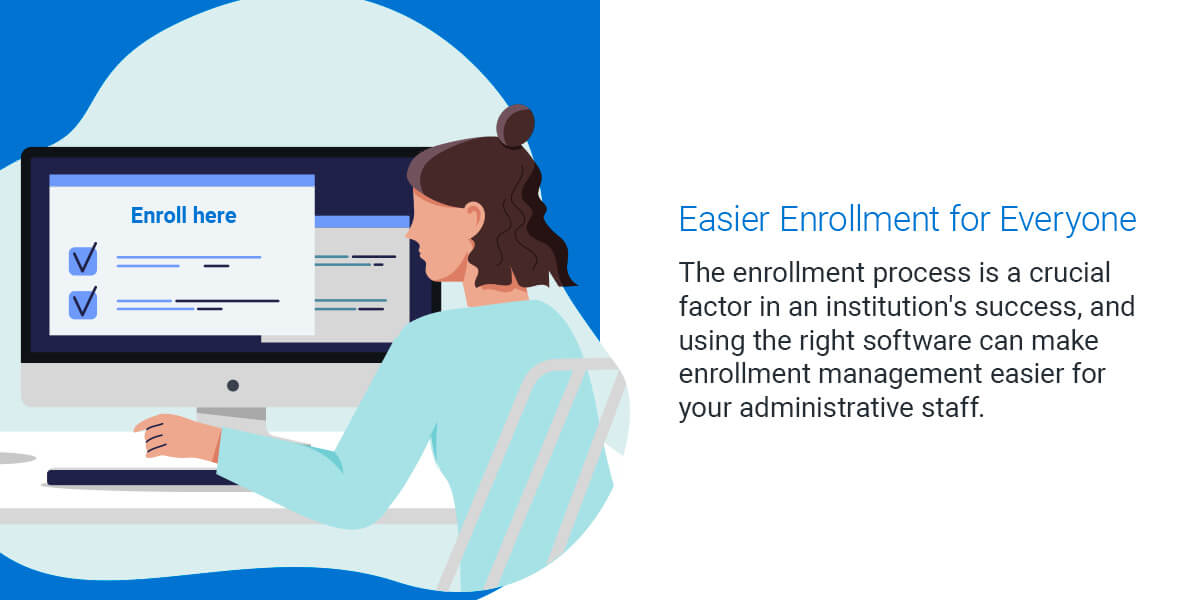
The enrollment process is a crucial factor in an institution’s success, and using the right software can make enrollment management easier for your administrative staff. Enrollment management refers to using strategies for enrollment decisions to help you achieve your goals. Enrollment management often includes marketing campaigns, scholarship programs, and other financial aid programs to increase retention rates.
The more successful your enrollment management strategy is, the better your school can foster student learning. It becomes challenging to sustain your school’s success and provide an exceptional education to your students without quality enrollment rates. That’s why it’s essential to focus on improving the enrollment process through an online enrollment management system. Using digitized school enrollment software can help make the process easier for your school, parents, and prospective students. The benefits of this software include:
- Faster enrollment process: Enrollment comprises many aspects, including contract delivery and deposit collections. When you connect admissions and enrollment, it can help speed up the process. For example, when you move admitted students from Ravenna into BigSIS for enrollment, you can deliver agreements to families within seconds or send invoices to collect deposits online. You can also create customized contracts to suit your needs, whether you’re looking to collect essential data or add unique attachments.
- Reduced need for paper filing systems: Solutions that include enrollment management functions, like BigSIS, allow you to stop using outdated paper filing systems where files can get lost or damaged. You also won’t have to spend as much time sorting through all the paperwork to find the necessary information. With BigSIS plus Ravenna, the data is at your fingertips in one convenient place. An online system can also make enrollment easier for families since they won’t have to print out any paperwork or deliver it to your location. Instead, they can complete the enrollment information online and give it electronically within seconds.
- Faster data collection: Digitized enrollment software uses automated tools to improve your enrollment process. Automation can collect data quickly and allows you to access any student’s data in one place at the click of a button. You can even customize these automated processes to suit the unique interests of your applicants. Faster data collection will also help you move through the enrollment process more quickly, allowing you to respond to families sooner with your decision letters.
Simplify Tuition Collection
Financial concerns can often be a significant problem for schools as tuition costs can dissuade families from enrolling and prevent your institution from receiving the funds you need to be successful. Once admitted students are moved from Ravenna to BigSIS for enrollment, their information is stored in BigSIS and can be used with BigSIS Tuition Management.
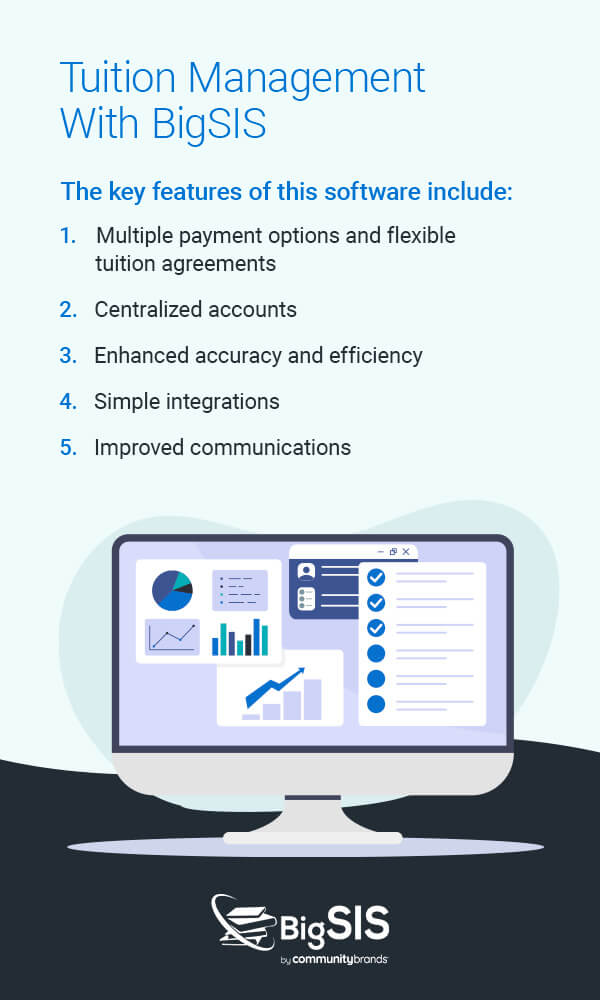
The key features of this software include:
- Multiple payment options and flexible tuition agreements: Some families are willing to enroll their children at your institution but might need help covering the costs. This software lets you easily meet families where they are, allowing them to make scheduled payments. You can customize flexible tuition terms to accommodate different families’ needs while sustaining your school’s financial stability. Providing these options to families allows you to maintain a diverse student body and helps ensure long-term success.
- Centralized accounts: Families benefit from a centralized account to manage their tuition payments in one location, regardless of the number of children they have enrolled. They won’t be required to make multiple accounts or provide identical information to make additional payments, saving time and effort while making it easier for your institution to collect tuition. The streamlined payment process will also be more straightforward for families to meet deadlines.
- Enhanced accuracy and efficiency: Automated software can help you collect tuition payments, deposits, and fees through a simple process. You’ll save valuable time and reduce the risk of errors that could slow tuition payments. The software also allows you to create customized invoices, send payment reminders, and automatically apply awards or credits to families’ accounts. Automated reporting helps ensure your data and collections are accurate and up-to-date.
- Simple integrations: Transferring data manually during the primary admissions and enrollment season can be time-consuming. The automated software can transfer essential data from enrollment to tuition for you, including financial aid awards, deposits, and remaining tuition amounts.
- Improved communications: Customize your communications with families, allowing you to send invoices and reminders to the correct accounts. You can customize your communications to reflect your institution’s mission and unique brand, personalizing your contact with families and helping build your relationship.
Ravenna and BigSIS allow you to exceed families’ expectations and streamline processes. The software can integrate all your processes into one convenient location, improving your overall workflow, reducing the risk of errors, and increasing your chance of long-term success. Enrollment and tuition software should be a part of your digital transformation strategy to help you revolutionize your school and make the most of the digital landscape.
Bring Your School Into the Future
Ravenna can help your school update its outdated systems and processes, often frustrating families and administrative staff. If your school relies on paper filing systems or traditional processes, which make admissions, enrollment, and tuition practices challenging, consider partnering with Ravenna to streamline your operations. Digital transformation ensures your school updates its technology and improves all systems and strategies for student assistance, teaching, data input, and finances.
Ravenna’s software helps bring your school into the digital world and prepares you for the future. Transforming your current processes with this software can help your school in many ways, including centralizing your data, improving relationships with families, and enhancing your admissions and enrollment processes to increase student retention. Try Ravenna’s software demo today or contact us online and learn how we can help set your school apart from the rest.
